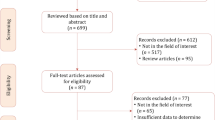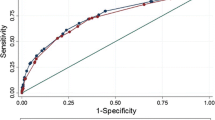Abstract
Objectives
To evaluate the diagnostic performance of preoperative multiparametric MRI with extracapsular extension (ECE) risk-scoring in the assessment of prostate cancer tumour stage (T-stage) and prediction of ECE at final pathology.
Materials and Methods
Eighty-seven patients with clinically localised prostate cancer scheduled for radical prostatectomy were prospectively enrolled. Multiparametric MRI was performed prior to prostatectomy, and evaluated according to the ESUR MR prostate guidelines by two different readers. An MRI clinical T-stage (cTMRI), an ECE risk score, and suspicion of ECE based on tumour characteristics and personal opinion were assigned. Histopathological prostatectomy results were standard reference.
Results
Histopathology and cTMRI showed a spearman rho correlation of 0.658 (p < 0.001) and a weighted kappa = 0.585 [CI 0.44;0.73](reader A). ECE was present in 31/87 (36 %) patients. ECE risk-scoring showed an AUC of 0.65–0.86 on ROC-curve for both readers, with sensitivity and specificity of 81 % and 78 % at best cutoff level (reader A), respectively. When tumour characteristics were influenced by personal opinion, the sensitivity and specificity for prediction of ECE changed to 61 %–74 % and 77 %-88 % for the readers, respectively.
Conclusions
Multiparametric MRI with ECE risk-scoring is an accurate diagnostic technique in determining prostate cancer clinical tumour stage and ECE at final pathology.
Key Points
• Multiparametric MRI is an accurate diagnostic technique for preoperative prostate cancer staging
• ECE risk scoring predicts extracapsular tumour extension at final pathology
• ECE risk scoring shows an AUC of 0.86 on the ROC-curve
• ECE risk scoring shows a moderate inter-reader agreement (K = 0.45)
• Multiparametric MRI provides essential knowledge for optimal clinical management




Similar content being viewed by others
Abbreviations
- DRE:
-
Digital rectal examination
- TRUS:
-
Transrectal ultrasound
- PCa:
-
Prostate cancer
- EPE:
-
Extraprostatic tumour extension
- RP:
-
Radical prostatectomy
- cT:
-
Clinical tumour stage
- NVB:
-
Neurovascular bundle
- MRI:
-
Magnetic resonance imaging
- Mp-MRI:
-
Multiparametric MRI
- PIRADS:
-
Prostate imaging reporting and data system
- T2W:
-
T2-weighted
- DWI:
-
Diffusion-weighted imaging
- ADC:
-
Apparent diffusion coefficient
- DCE:
-
Dynamic contrast-enhanced
- ECE:
-
Extracapsular extension
- SVI:
-
Seminal vesicle invasion
- GS:
-
Gleason score
- ERC:
-
Endorectal coil
References
Heidenreich A, Bastian PJ, Bellmunt J et al (2014) EAU guidelines on prostate cancer. part 1: screening, diagnosis, and local treatment with curative intent-update 2013. Eur Urol 65:124–137
Mullerad M, Hricak H, Kuroiwa K et al (2005) Comparison of endorectal magnetic resonance imaging, guided prostate biopsy and digital rectal examination in the preoperative anatomical localization of prostate cancer. J Urol 174:2158–2163
Grossfeld GD, Chang JJ, Broering JM et al (2001) Under staging and under grading in a contemporary series of patients undergoing radical prostatectomy: results from the Cancer of the Prostate Strategic Urologic Research Endeavor database. J Urol 165:851–856
Soulié M (2008) What is the role of surgery for locally advanced disease? Eur Urol Suppl 7:400–405
Sciarra A, Barentsz J, Bjartell A et al (2011) Advances in magnetic resonance imaging: how they are changing the management of prostate cancer. Eur Urol 59:962–977
Fütterer JJ, Engelbrecht MR, Jager GJ et al (2007) Prostate cancer: comparison of local staging accuracy of pelvic phased-array coil alone versus integrated endorectal-pelvic phased-array coils. Local staging accuracy of prostate cancer using endorectal coil MR imaging. Eur Radiol 17:1055–1065
Mullerad M, Hricak H, Wang L, Chen H-N, Kattan MW, Scardino PT (2004) Prostate cancer: detection of extracapsular extension by genitourinary and general body radiologists at MR imaging. Radiology 232:140–146
Brajtbord JS, Lavery HJ, Nabizada-Pace F, Senaratne P, Samadi DB (2011) Endorectal magnetic resonance imaging has limited clinical ability to preoperatively predict pT3 prostate cancer. BJU Int 107:1419–1424
Hegde JV, Chen M-H, Mulkern RV, Fennessy FM, D’Amico AV, Tempany CMC (2013) Preoperative 3-Tesla multiparametric endorectal magnetic resonance imaging findings and the odds of upgrading and upstaging at radical prostatectomy in men with clinically localized prostate cancer. Int J Radiat Oncol Biol Phys 85:101–107
Renard-Penna R, Rouprêt M, Comperat E et al (2013) Accuracy of high resolution (1.5 tesla) pelvic phased array magnetic resonance imaging (MRI) in staging prostate cancer in candidates for radical prostatectomy: results from a prospective study. Urol Oncol 31:448–454
Heidenreich A (2011) Consensus criteria for the use of magnetic resonance imaging in the diagnosis and staging of prostate cancer: not ready for routine use. Eur Urol 59:495–497
Barentsz JO, Richenberg J, Clements R et al (2012) ESUR prostate MR guidelines 2012. Eur Radiol 22:746–757
Portalez D, Mozer P, Cornud F et al (2012) Validation of the European Society of Urogenital Radiology scoring system for prostate cancer diagnosis on multiparametric magnetic resonance imaging in a cohort of repeat biopsy patients. Eur Urol 62:986–996
Röthke M, Blondin D, Schlemmer H-P, Franiel T (2013) PI-RADS classification: structured reporting for MRI of the prostate. Röfo 185:253–261
Boesen L, Noergaard N, Chabanova E et al (2014) Early experience with multiparametric magnetic resonance imaging-targeted biopsies under visual transrectal ultrasound guidance in patients suspicious for prostate cancer undergoing repeated biopsy. Scand J Urol. doi:10.3109/21681805.2014.9
Rosenkrantz AB, Kim S, Lim RP et al (2013) Prostate cancer localization using multiparametric MR imaging: comparison of Prostate Imaging Reporting and Data System (PI-RADS) and Likert scales. Radiology 269:482–492
Roethke MC, Kuru TH, Schultze S et al (2014) Evaluation of the ESUR PI-RADS scoring system for multiparametric MRI of the prostate with targeted MR/TRUS fusion-guided biopsy at 3.0 Tesla. Eur Radiol 24:344–352
Sobin L, Gospodarowicz MWC (2009) TNM classification of malignant tumours. Urological tumours, 7th edn. Wiley-Blackwell, Hoboken
Landis JR, Koch GG (1977) The measurement of observer agreement for categorical data. Biometrics 33:159–174
Rosenkrantz AB, Chandarana H, Gilet A et al (2013) Prostate cancer: utility of diffusion-weighted imaging as a marker of side-specific risk of extracapsular extension. J Magn Reson Imaging 38:312–319
Chong Y, Kim CK, Park SY, Park BK, Kwon GY, Park JJ (2014) Value of diffusion-weighted imaging at 3 T for prediction of extracapsular extension in patients with prostate cancer: a preliminary study. AJR Am J Roentgenol 202:772–777
Bloch BN, Furman-Haran E, Helbich TH et al (2007) Prostate cancer: accurate determination of extracapsular extension with high-spatial-resolution dynamic contrast-enhanced and T2-weighted MR imaging–initial results. Radiology 245:176–185
Fütterer JJ, Engelbrecht MR, Huisman HJ et al (2005) Staging prostate cancer with dynamic contrast-enhanced endorectal MR imaging prior to radical prostatectomy: experienced versus less experienced readers. Radiology 237:541–549
Engelbrecht MR, Jager GJ, Laheij RJ, Verbeek ALM, van Lier HJ, Barentsz JO (2002) Local staging of prostate cancer using magnetic resonance imaging: a meta-analysis. Eur Radiol 12:2294–2302
Fütterer JJ, Heijmink SWTPJ, Scheenen TWJ et al (2006) Prostate cancer: local staging at 3-T endorectal MR imaging–early experience. Radiology 238:184–191
Heijmink SWTPJ, Fütterer JJ, Hambrock T et al (2007) Prostate cancer: body-array versus endorectal coil MR imaging at 3 T–comparison of image quality, localization, and staging performance. Radiology 244:184–195
Ward JF, Slezak JM, Blute ML, Bergstralh EJ, Zincke H (2005) Radical prostatectomy for clinically advanced (cT3) prostate cancer since the advent of prostate-specific antigen testing: 15-year outcome. BJU Int 95:751–756
Hsu C-Y, Joniau S, Oyen R, Roskams T, Van Poppel H (2007) Outcome of surgery for clinical unilateral T3a prostate cancer: a single-institution experience. Eur Urol 51:121–128, discussion 128–9
Mitchell CR, Boorjian SA, Umbreit EC, Rangel LJ, Carlson RE, Karnes RJ (2012) 20-Year survival after radical prostatectomy as initial treatment for cT3 prostate cancer. BJU Int 110:1709–1713
Spahn M, Briganti A, Capitanio U et al (2012) Outcome predictors of radical prostatectomy followed by adjuvant androgen deprivation in patients with clinical high risk prostate cancer and pT3 surgical margin positive disease. J Urol 188:84–90
Wang L, Hricak H, Kattan MW, Chen H-N, Scardino PT, Kuroiwa K (2006) Prediction of organ-confined prostate cancer: incremental value of MR imaging and MR spectroscopic imaging to staging nomograms. Radiology 238:597–603
Shukla-Dave A, Hricak H, Akin O et al (2012) Preoperative nomograms incorporating magnetic resonance imaging and spectroscopy for prediction of insignificant prostate cancer. BJU Int 109:1315–1322
Ruprecht O, Weisser P, Bodelle B, Ackermann H, Vogl TJ (2012) MRI of the prostate: interobserver agreement compared with histopathologic outcome after radical prostatectomy. Eur J Radiol 81:456–460
Garcia-Reyes K, Passoni NM, Palmeri ML et al (2014) Detection of prostate cancer with multiparametric MRI (mpMRI): effect of dedicated reader education on accuracy and confidence of index and anterior cancer diagnosis. Abdom Imaging. doi:10.1007/s00261-014-019
Turkbey B, Merino MJ, Gallardo EC et al (2014) Comparison of endorectal coil and nonendorectal coil T2W and diffusion-weighted MRI at 3 Tesla for localizing prostate cancer: correlation with whole-mount histopathology. J Magn Reson Imaging 39:1443–1448
Acknowledgments
The scientific guarantor of this publication is Henrik S. Thomsen. The authors of this manuscript declare no relationships with any companies whose products or services may be related to the subject matter of the article. The authors state that this work has not received any funding. No complex statistical methods were necessary for this paper. Institutional Review Board approval was obtained. Written informed consent was obtained from all subjects (patients) in this study. Approval from the institutional animal care committee was not required because the study was not on animals. Methodology: prospective, diagnostic, or prognostic study, performed at one institution.
Author information
Authors and Affiliations
Corresponding author
Rights and permissions
About this article
Cite this article
Boesen, L., Chabanova, E., Løgager, V. et al. Prostate cancer staging with extracapsular extension risk scoring using multiparametric MRI: a correlation with histopathology. Eur Radiol 25, 1776–1785 (2015). https://doi.org/10.1007/s00330-014-3543-9
Received:
Revised:
Accepted:
Published:
Issue Date:
DOI: https://doi.org/10.1007/s00330-014-3543-9




